Wireless Technologies Report: WLAN, FHSS/DSSS, and Antenna Analysis
VerifiedAdded on 2020/05/11
|5
|1160
|92
Report
AI Summary
This report provides an evaluation of various wireless technologies. It begins with an analysis of Wireless LAN (WLAN) technologies, comparing 802.11b, 802.11g, 802.11n, and 802.11ac, ultimately recommending 802.11ac for its high bandwidth and compatibility. The report then compares FHSS and DSSS, highlighting differences in speed, connectivity, power consumption, cost efficiency, interference resistance, and channel usage. Finally, it discusses different types of antennas, including dish, grid, sector, and omni antennas, offering recommendations based on organizational communication needs. The report concludes with a recommendation of sector antennas for efficient communication within an organization and dish antennas for geographically large requirements.
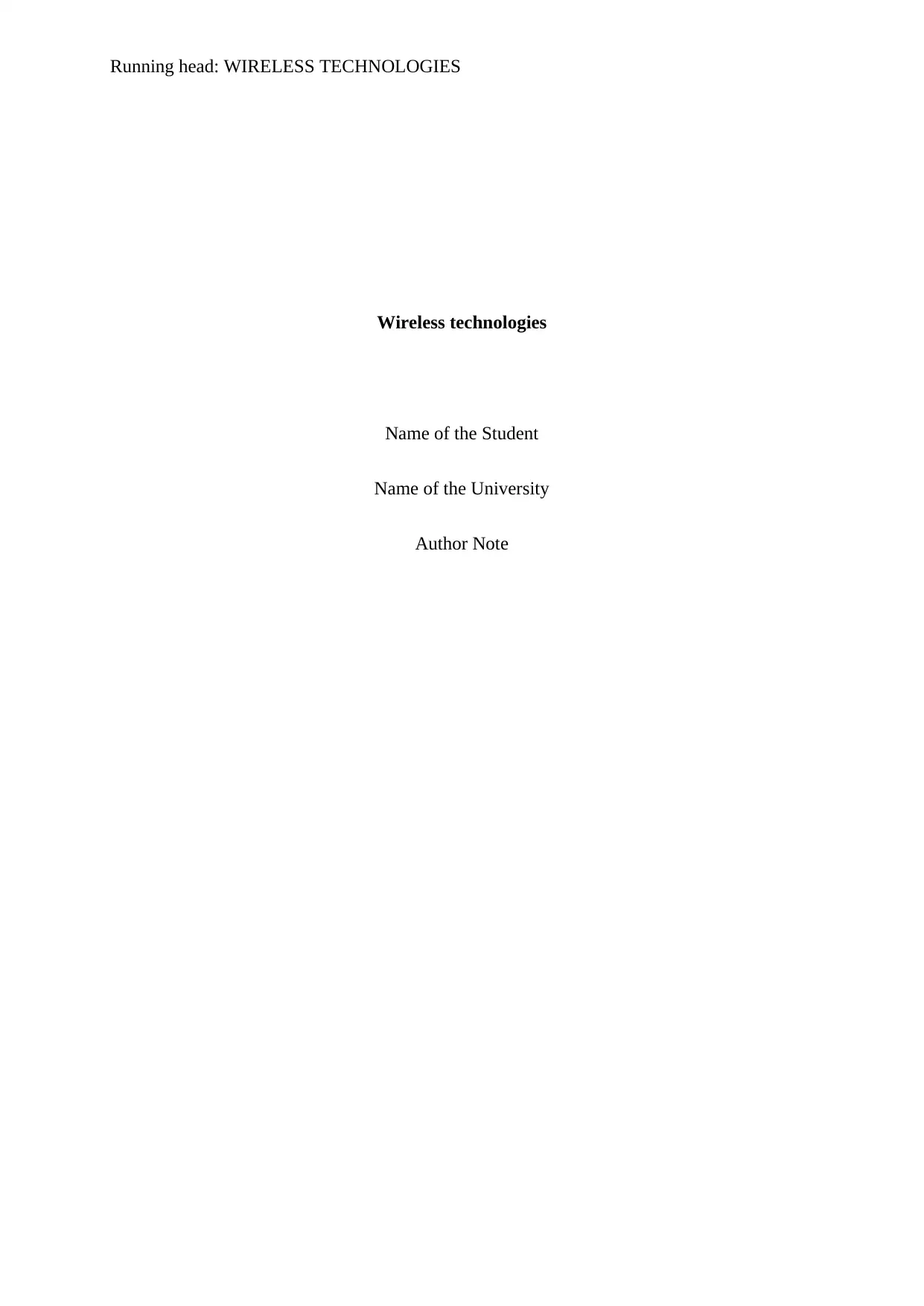
Running head: WIRELESS TECHNOLOGIES
Wireless technologies
Name of the Student
Name of the University
Author Note
Wireless technologies
Name of the Student
Name of the University
Author Note
Paraphrase This Document
Need a fresh take? Get an instant paraphrase of this document with our AI Paraphraser
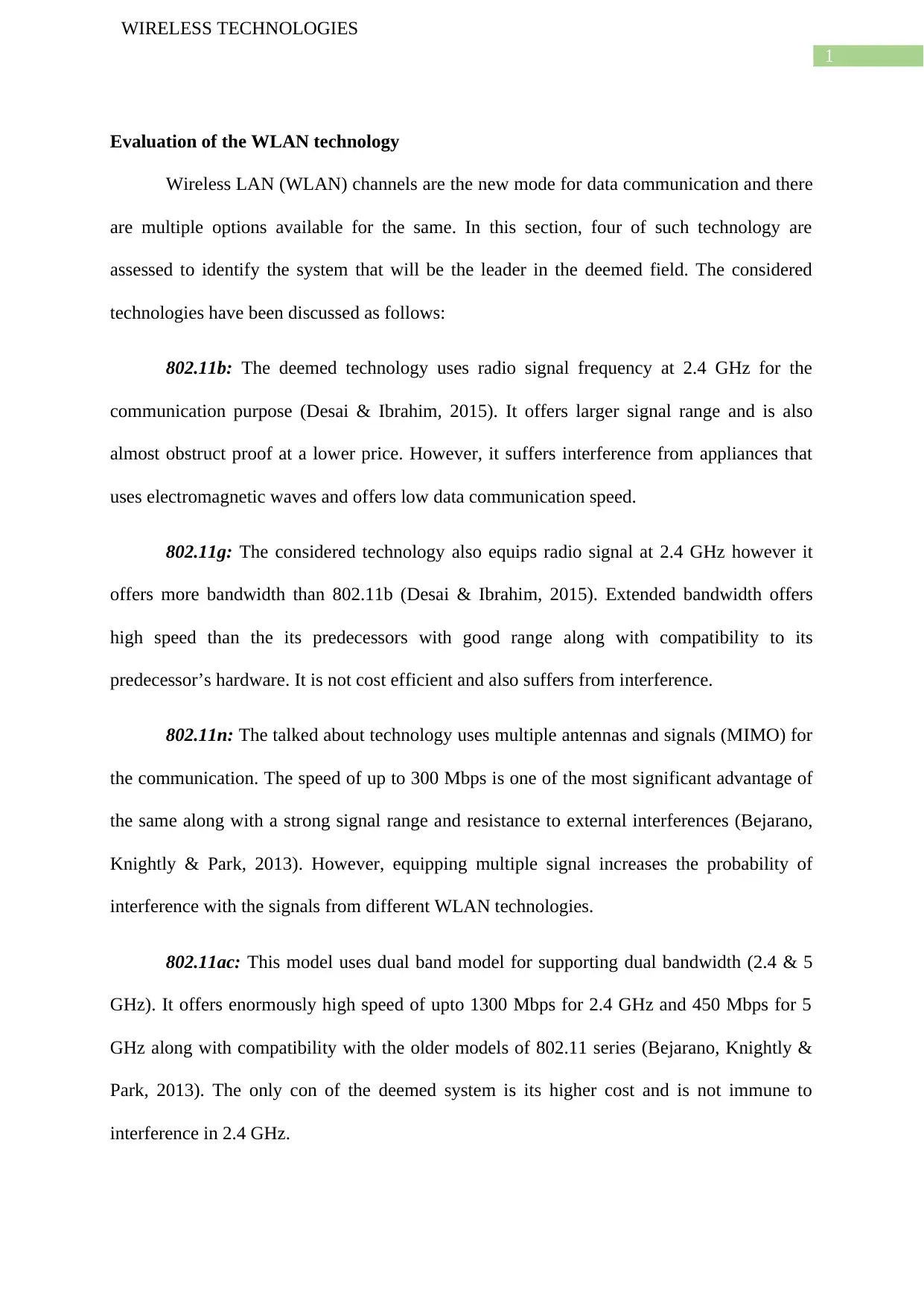
1
WIRELESS TECHNOLOGIES
Evaluation of the WLAN technology
Wireless LAN (WLAN) channels are the new mode for data communication and there
are multiple options available for the same. In this section, four of such technology are
assessed to identify the system that will be the leader in the deemed field. The considered
technologies have been discussed as follows:
802.11b: The deemed technology uses radio signal frequency at 2.4 GHz for the
communication purpose (Desai & Ibrahim, 2015). It offers larger signal range and is also
almost obstruct proof at a lower price. However, it suffers interference from appliances that
uses electromagnetic waves and offers low data communication speed.
802.11g: The considered technology also equips radio signal at 2.4 GHz however it
offers more bandwidth than 802.11b (Desai & Ibrahim, 2015). Extended bandwidth offers
high speed than the its predecessors with good range along with compatibility to its
predecessor’s hardware. It is not cost efficient and also suffers from interference.
802.11n: The talked about technology uses multiple antennas and signals (MIMO) for
the communication. The speed of up to 300 Mbps is one of the most significant advantage of
the same along with a strong signal range and resistance to external interferences (Bejarano,
Knightly & Park, 2013). However, equipping multiple signal increases the probability of
interference with the signals from different WLAN technologies.
802.11ac: This model uses dual band model for supporting dual bandwidth (2.4 & 5
GHz). It offers enormously high speed of upto 1300 Mbps for 2.4 GHz and 450 Mbps for 5
GHz along with compatibility with the older models of 802.11 series (Bejarano, Knightly &
Park, 2013). The only con of the deemed system is its higher cost and is not immune to
interference in 2.4 GHz.
WIRELESS TECHNOLOGIES
Evaluation of the WLAN technology
Wireless LAN (WLAN) channels are the new mode for data communication and there
are multiple options available for the same. In this section, four of such technology are
assessed to identify the system that will be the leader in the deemed field. The considered
technologies have been discussed as follows:
802.11b: The deemed technology uses radio signal frequency at 2.4 GHz for the
communication purpose (Desai & Ibrahim, 2015). It offers larger signal range and is also
almost obstruct proof at a lower price. However, it suffers interference from appliances that
uses electromagnetic waves and offers low data communication speed.
802.11g: The considered technology also equips radio signal at 2.4 GHz however it
offers more bandwidth than 802.11b (Desai & Ibrahim, 2015). Extended bandwidth offers
high speed than the its predecessors with good range along with compatibility to its
predecessor’s hardware. It is not cost efficient and also suffers from interference.
802.11n: The talked about technology uses multiple antennas and signals (MIMO) for
the communication. The speed of up to 300 Mbps is one of the most significant advantage of
the same along with a strong signal range and resistance to external interferences (Bejarano,
Knightly & Park, 2013). However, equipping multiple signal increases the probability of
interference with the signals from different WLAN technologies.
802.11ac: This model uses dual band model for supporting dual bandwidth (2.4 & 5
GHz). It offers enormously high speed of upto 1300 Mbps for 2.4 GHz and 450 Mbps for 5
GHz along with compatibility with the older models of 802.11 series (Bejarano, Knightly &
Park, 2013). The only con of the deemed system is its higher cost and is not immune to
interference in 2.4 GHz.
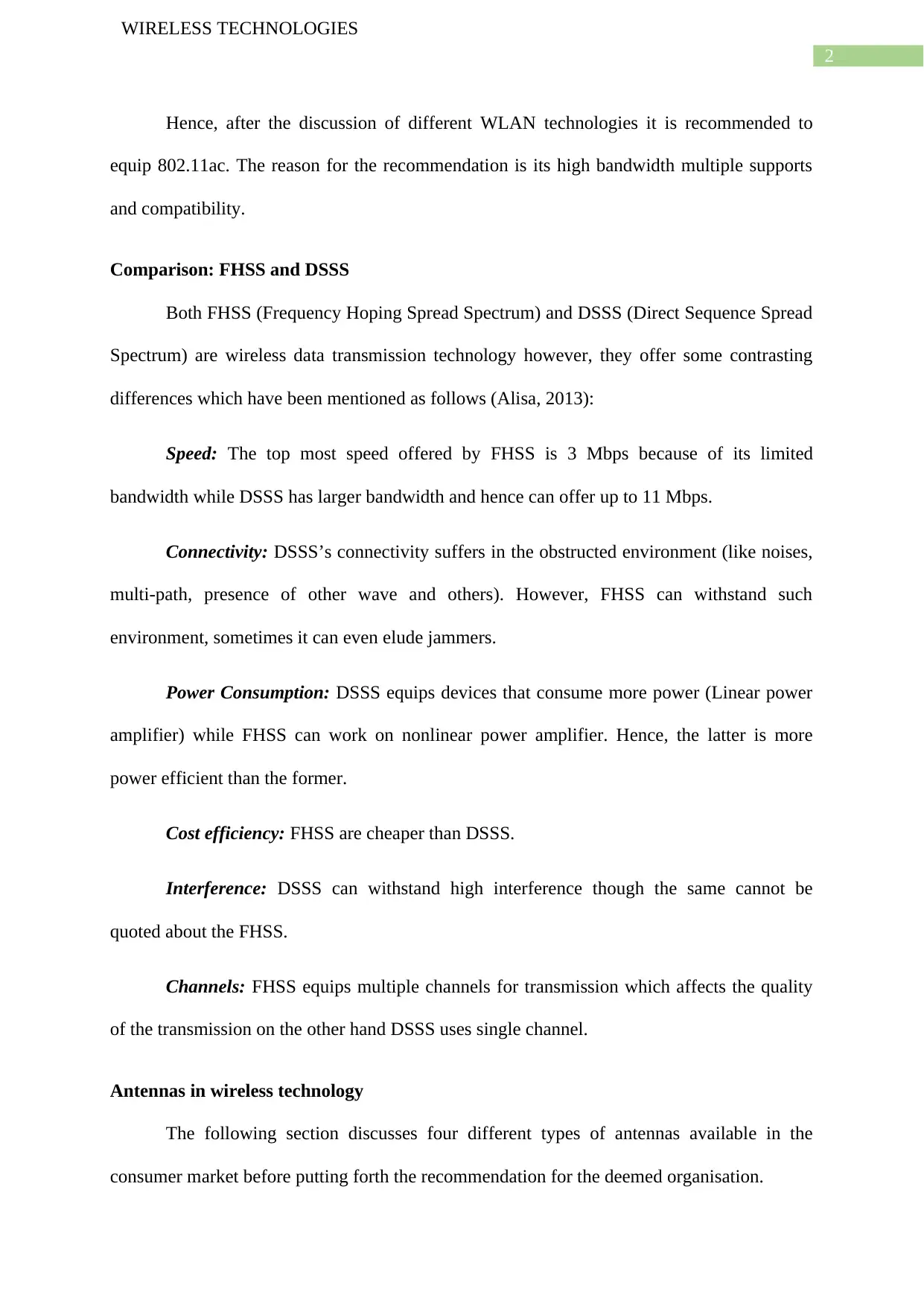
2
WIRELESS TECHNOLOGIES
Hence, after the discussion of different WLAN technologies it is recommended to
equip 802.11ac. The reason for the recommendation is its high bandwidth multiple supports
and compatibility.
Comparison: FHSS and DSSS
Both FHSS (Frequency Hoping Spread Spectrum) and DSSS (Direct Sequence Spread
Spectrum) are wireless data transmission technology however, they offer some contrasting
differences which have been mentioned as follows (Alisa, 2013):
Speed: The top most speed offered by FHSS is 3 Mbps because of its limited
bandwidth while DSSS has larger bandwidth and hence can offer up to 11 Mbps.
Connectivity: DSSS’s connectivity suffers in the obstructed environment (like noises,
multi-path, presence of other wave and others). However, FHSS can withstand such
environment, sometimes it can even elude jammers.
Power Consumption: DSSS equips devices that consume more power (Linear power
amplifier) while FHSS can work on nonlinear power amplifier. Hence, the latter is more
power efficient than the former.
Cost efficiency: FHSS are cheaper than DSSS.
Interference: DSSS can withstand high interference though the same cannot be
quoted about the FHSS.
Channels: FHSS equips multiple channels for transmission which affects the quality
of the transmission on the other hand DSSS uses single channel.
Antennas in wireless technology
The following section discusses four different types of antennas available in the
consumer market before putting forth the recommendation for the deemed organisation.
WIRELESS TECHNOLOGIES
Hence, after the discussion of different WLAN technologies it is recommended to
equip 802.11ac. The reason for the recommendation is its high bandwidth multiple supports
and compatibility.
Comparison: FHSS and DSSS
Both FHSS (Frequency Hoping Spread Spectrum) and DSSS (Direct Sequence Spread
Spectrum) are wireless data transmission technology however, they offer some contrasting
differences which have been mentioned as follows (Alisa, 2013):
Speed: The top most speed offered by FHSS is 3 Mbps because of its limited
bandwidth while DSSS has larger bandwidth and hence can offer up to 11 Mbps.
Connectivity: DSSS’s connectivity suffers in the obstructed environment (like noises,
multi-path, presence of other wave and others). However, FHSS can withstand such
environment, sometimes it can even elude jammers.
Power Consumption: DSSS equips devices that consume more power (Linear power
amplifier) while FHSS can work on nonlinear power amplifier. Hence, the latter is more
power efficient than the former.
Cost efficiency: FHSS are cheaper than DSSS.
Interference: DSSS can withstand high interference though the same cannot be
quoted about the FHSS.
Channels: FHSS equips multiple channels for transmission which affects the quality
of the transmission on the other hand DSSS uses single channel.
Antennas in wireless technology
The following section discusses four different types of antennas available in the
consumer market before putting forth the recommendation for the deemed organisation.
⊘ This is a preview!⊘
Do you want full access?
Subscribe today to unlock all pages.

Trusted by 1+ million students worldwide
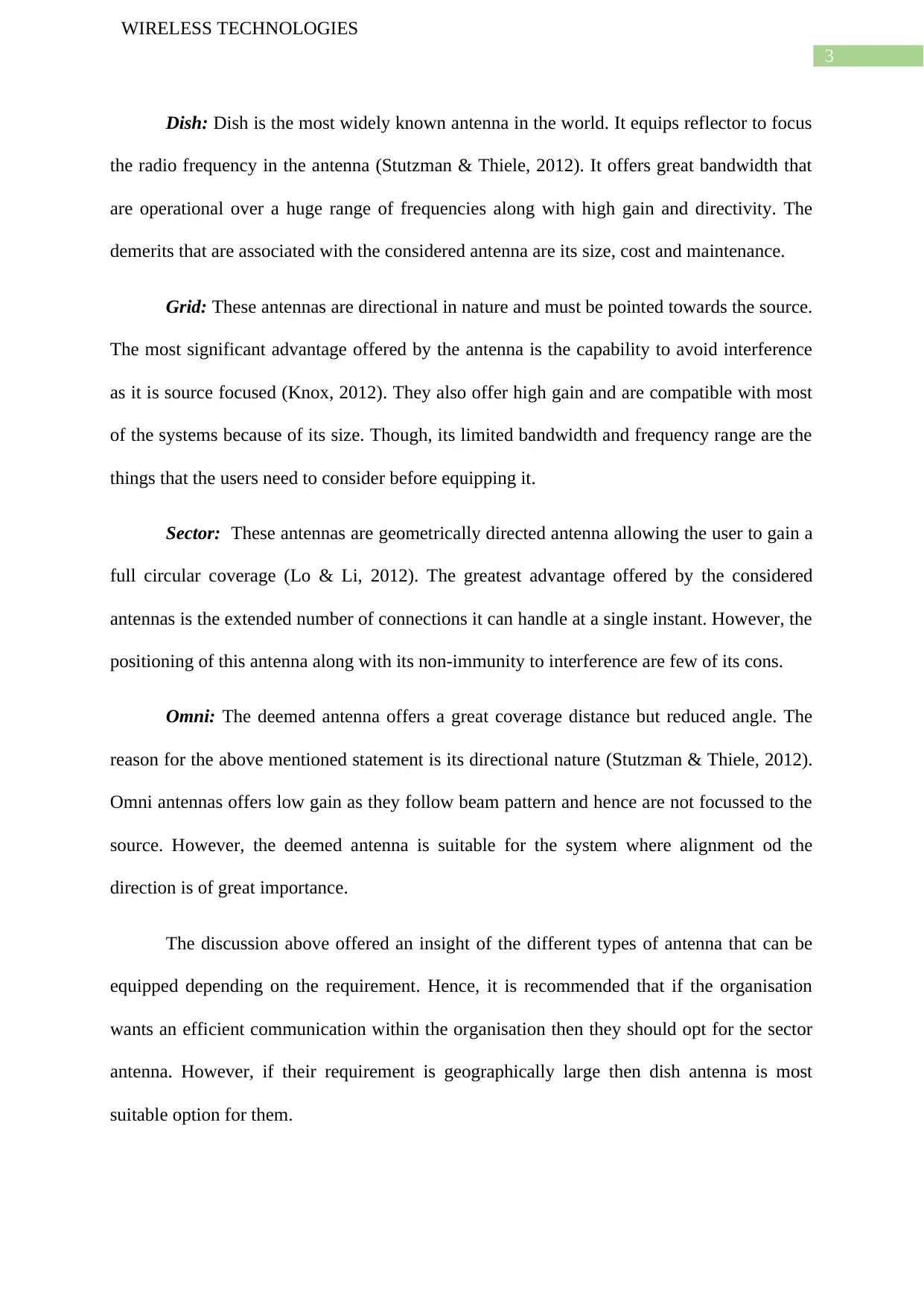
3
WIRELESS TECHNOLOGIES
Dish: Dish is the most widely known antenna in the world. It equips reflector to focus
the radio frequency in the antenna (Stutzman & Thiele, 2012). It offers great bandwidth that
are operational over a huge range of frequencies along with high gain and directivity. The
demerits that are associated with the considered antenna are its size, cost and maintenance.
Grid: These antennas are directional in nature and must be pointed towards the source.
The most significant advantage offered by the antenna is the capability to avoid interference
as it is source focused (Knox, 2012). They also offer high gain and are compatible with most
of the systems because of its size. Though, its limited bandwidth and frequency range are the
things that the users need to consider before equipping it.
Sector: These antennas are geometrically directed antenna allowing the user to gain a
full circular coverage (Lo & Li, 2012). The greatest advantage offered by the considered
antennas is the extended number of connections it can handle at a single instant. However, the
positioning of this antenna along with its non-immunity to interference are few of its cons.
Omni: The deemed antenna offers a great coverage distance but reduced angle. The
reason for the above mentioned statement is its directional nature (Stutzman & Thiele, 2012).
Omni antennas offers low gain as they follow beam pattern and hence are not focussed to the
source. However, the deemed antenna is suitable for the system where alignment od the
direction is of great importance.
The discussion above offered an insight of the different types of antenna that can be
equipped depending on the requirement. Hence, it is recommended that if the organisation
wants an efficient communication within the organisation then they should opt for the sector
antenna. However, if their requirement is geographically large then dish antenna is most
suitable option for them.
WIRELESS TECHNOLOGIES
Dish: Dish is the most widely known antenna in the world. It equips reflector to focus
the radio frequency in the antenna (Stutzman & Thiele, 2012). It offers great bandwidth that
are operational over a huge range of frequencies along with high gain and directivity. The
demerits that are associated with the considered antenna are its size, cost and maintenance.
Grid: These antennas are directional in nature and must be pointed towards the source.
The most significant advantage offered by the antenna is the capability to avoid interference
as it is source focused (Knox, 2012). They also offer high gain and are compatible with most
of the systems because of its size. Though, its limited bandwidth and frequency range are the
things that the users need to consider before equipping it.
Sector: These antennas are geometrically directed antenna allowing the user to gain a
full circular coverage (Lo & Li, 2012). The greatest advantage offered by the considered
antennas is the extended number of connections it can handle at a single instant. However, the
positioning of this antenna along with its non-immunity to interference are few of its cons.
Omni: The deemed antenna offers a great coverage distance but reduced angle. The
reason for the above mentioned statement is its directional nature (Stutzman & Thiele, 2012).
Omni antennas offers low gain as they follow beam pattern and hence are not focussed to the
source. However, the deemed antenna is suitable for the system where alignment od the
direction is of great importance.
The discussion above offered an insight of the different types of antenna that can be
equipped depending on the requirement. Hence, it is recommended that if the organisation
wants an efficient communication within the organisation then they should opt for the sector
antenna. However, if their requirement is geographically large then dish antenna is most
suitable option for them.
Paraphrase This Document
Need a fresh take? Get an instant paraphrase of this document with our AI Paraphraser
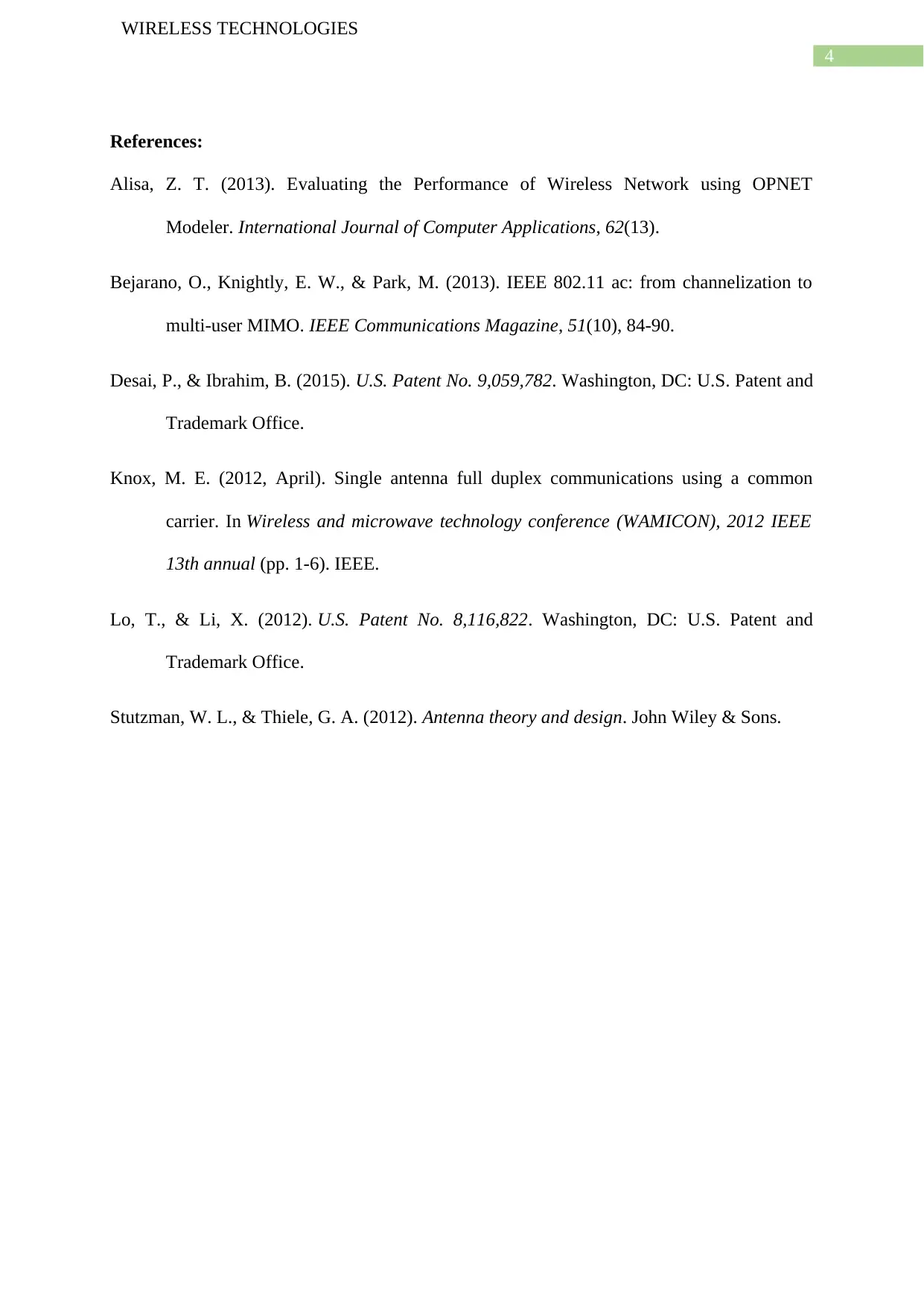
4
WIRELESS TECHNOLOGIES
References:
Alisa, Z. T. (2013). Evaluating the Performance of Wireless Network using OPNET
Modeler. International Journal of Computer Applications, 62(13).
Bejarano, O., Knightly, E. W., & Park, M. (2013). IEEE 802.11 ac: from channelization to
multi-user MIMO. IEEE Communications Magazine, 51(10), 84-90.
Desai, P., & Ibrahim, B. (2015). U.S. Patent No. 9,059,782. Washington, DC: U.S. Patent and
Trademark Office.
Knox, M. E. (2012, April). Single antenna full duplex communications using a common
carrier. In Wireless and microwave technology conference (WAMICON), 2012 IEEE
13th annual (pp. 1-6). IEEE.
Lo, T., & Li, X. (2012). U.S. Patent No. 8,116,822. Washington, DC: U.S. Patent and
Trademark Office.
Stutzman, W. L., & Thiele, G. A. (2012). Antenna theory and design. John Wiley & Sons.
WIRELESS TECHNOLOGIES
References:
Alisa, Z. T. (2013). Evaluating the Performance of Wireless Network using OPNET
Modeler. International Journal of Computer Applications, 62(13).
Bejarano, O., Knightly, E. W., & Park, M. (2013). IEEE 802.11 ac: from channelization to
multi-user MIMO. IEEE Communications Magazine, 51(10), 84-90.
Desai, P., & Ibrahim, B. (2015). U.S. Patent No. 9,059,782. Washington, DC: U.S. Patent and
Trademark Office.
Knox, M. E. (2012, April). Single antenna full duplex communications using a common
carrier. In Wireless and microwave technology conference (WAMICON), 2012 IEEE
13th annual (pp. 1-6). IEEE.
Lo, T., & Li, X. (2012). U.S. Patent No. 8,116,822. Washington, DC: U.S. Patent and
Trademark Office.
Stutzman, W. L., & Thiele, G. A. (2012). Antenna theory and design. John Wiley & Sons.
1 out of 5
Related Documents
Your All-in-One AI-Powered Toolkit for Academic Success.
+13062052269
info@desklib.com
Available 24*7 on WhatsApp / Email
![[object Object]](/_next/static/media/star-bottom.7253800d.svg)
Unlock your academic potential
Copyright © 2020–2025 A2Z Services. All Rights Reserved. Developed and managed by ZUCOL.




